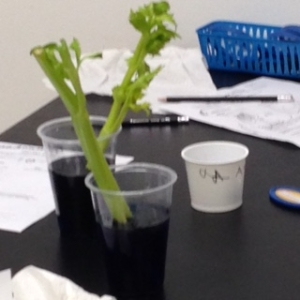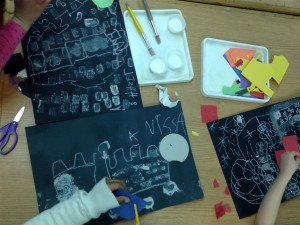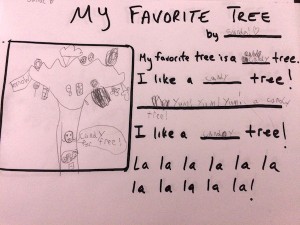ART WITH KARA
Pre-K (Dragonflies, Bumblebees & Beetles) There was a lot of excitement about the shadow puppet performances last month. So, in the beginning of February, the Bumblebees and Beetles revisited the puppets, by continuing the exploration of silhouettes versus the features within a shape. Students decided what details they would add to the puppets that would express the physical characteristics of their puppet. Then, we discussed the components of a good story, before they were once again back in the puppet theater trying their hand at performing stories with their finished puppets. After break, we moved into an even more tactile, kinesthetic medium-clay! The pre-k began their clay project by literally examining and digging into clay. Each table was given a 25 lb brick of clay and challenged to see how they could use their hands to alter or modify the brick. It was exciting to see how each table modified their clay differently and ended up with completely different results. This gave students the opportunity to get a sense of the physical properties of clay and ready to start their clay projects this week.
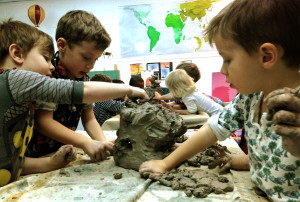
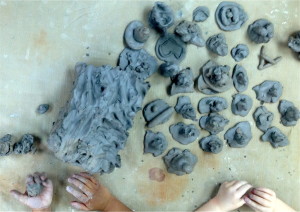
Kindergarten (Katydids) Building off of their inquiry focus, the Katydids started off February with a castle project. We began with a discussion sharing what we know about castles. Then, using black paper and white oil pastels students created an outline of their castle- thinking about wall design, shapes of towers, arrow slits and moats. We talked about how castles are usually made of stone, and students were quick to point out that there are different kinds of stone, erosion and moss, that can change the color and visual appearance of the castle. Students used small rectangular sponges, to stamp characteristics of stone onto their castles, finishing them up with additional collaged paper details. After break, we read the book, The Dot by Peter Reynolds. The Dot is a story about a hesitant student named Vashti who is encouraged to trust in her own abilities by being brave enough to “make her mark”. What begins with a small dot on a piece of paper becomes a breakthrough in confidence and courage. Using watercolor, the Katydids each made at least one dot. Students made the decision whether they would focus on the space inside the dot or the area outside the dot.
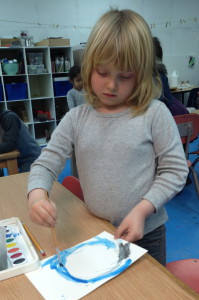

First Grade (Centipedes) has been constructing their perfect playgrounds. Staring with a discussion about what makes a great playground, students shared their favorite features-everything from slides to soccer fields, zip-lines to balance beams. Working in cardboard and foam core, students set-out to create their individual dream playground models. As classes continued, I added other materials to the resource table and students continued building up and personalizing their playground. Students who have completed the building portion of their playgrounds, have started disguising their building materials by adding tempera paint.
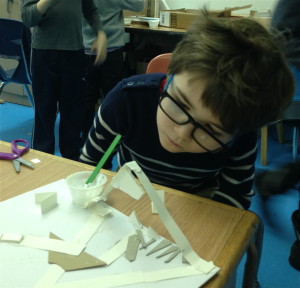
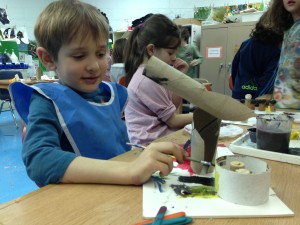
Second Grade (Sharks) continued their work with watercolors this month with a project that ties in with their tree inquiry. We began by looking at images of winter trees noticing the shapes in the silhouettes of trees and the colors of the sunsets and blue skies behind it. We talked about foreground and background and how the horizon line separates the earth from the sky. Students then created sunset skies for their backgrounds and experimented with using a straw to blow their winter tree silhouettes. Students finished by further developing a horizon line and creating a haiku poem describing their trees.
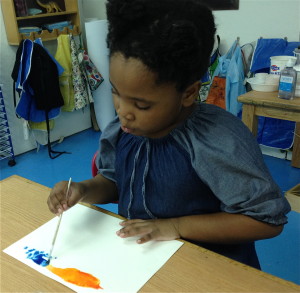
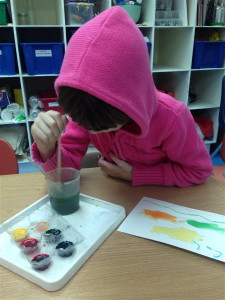
——————————————————
MUSIC WITH DAN
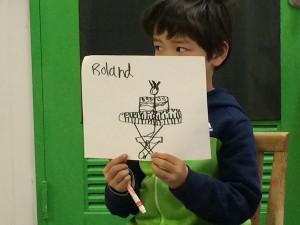
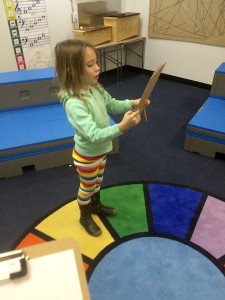
——————————————————
WOODSHOP WITH ROTEM!
PreK (The Bumblebees, Beetles and Dragonflies) completed their “Wishing Tree” projects. Having sawed, drilled and hammered individual branches all the parts came together to create one large tree. We discussed the shape of the tree and noticed how thinner branches grow out of the thicker trunk and how even thinner branches grow out of those. As a group the PreK’s then painted the tree from roots to the tips of the tinniest branches in brown. We took the chance to refresh some color mixing and learned how to make brown (yellow+red+a tiny amount of black). All that is missing now is to think about what to wish for. We started considering this and talked about different kinds of things to wish for—some wishes are for ourselves, some wishes can be for others and some wishes are more abstract and can be for the entire world. We talked about wishing for stuff we want, things we want to do and places we want to go (toys, live in a castle, see a rainbow); bringing imaginary things to life (making superheroes real, flying, being a cheetah) and hoping for a better world (that people wont be mean, that nobody dies, that people don’t litter).
The trees will be brought up to the classrooms where they can be used to explore changing seasons, the tree as a habitat or maybe even as a family tree. Looking forward to see what the trees will end up being and to more imagination-filled woodshop-adventures with the pre-K’s!
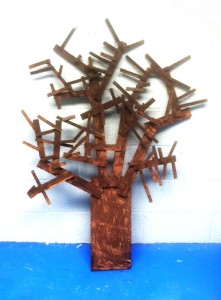
Kindergarten (Katydids) are busy making furniture for their mini-me’s. We began by making detailed plans. Each Katydid designed three different chairs. There were rolling chairs, rocking chairs, regular chairs, bat chairs, rocket chairs and more. Each student chose one of their designs and practiced taking it apart in their heads. They then drew and labeled all of the parts needed to make that specific chair. With this blueprint in hand construction could begin. Each student cut legs, seats, back rests, arm rests and decorative elements for their chair. We practiced marking lumber before cutting it and how to mark two pieces so that they will be the same length, practicing accuracy and being deliberate with our choices and actions. We will end up with a classroom full of different chairs for the mini-me’s very soon…
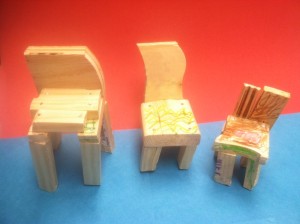
First Grade (Centipedes) continued building beds for their mini-me’s. this month. We saw how useful having a plan can be. When a problem presented itself we could always turn back to the original design and see what we had planned. The centipedes are becoming truly independent in the woodshop. Now that they know where everything is, what every tool does and what the right way to hold, walk with and use everything in the shop is they are fully in control of their projects. Each bed that the Centipedes are building is different and unique—bunk beds, princess beds, low beds, high beds, narrow beds, wide beds, rocket beds and more. We are considering what makes each project different and what they all share, thinking about form and function and understanding what is essential and what isn’t by making plans and drawings that consider the structure and the ornament — making plans that break down the project into the two categories. The Centipedes are also focusing on being accurate so that the beds don’t wobble and that all the parts attach. Can’t wait to see what they design next!
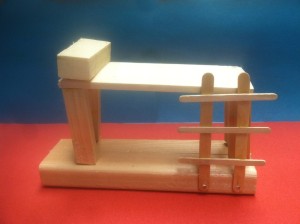
Second Grade (The Sharks) are hard at work building marionettes. We took a vote as to what the marionettes should be of and there was a nearly unanimous decision to make self portraits. We began with measuring and cutting the right length of wood for the different parts using a plan. The sharks each had to mark off the part they made using a cut-sheet. Now, when all the parts are assembled they began drilling holes to connect the limbs to themselves and then to the body. They are becoming experts on the drill making all those holes. Measuring, cutting and drilling into small pieces of wood is making everyone a lot more accurate and conscious of how and where they make cuts, marks and holes. Next up we need to construct the crossbars to control the puppets, design their heads and features, make their outfits and finally string them up and animate them!
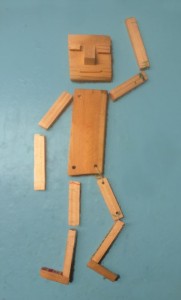
———————————————-
SCIENCE WITH NICOLE!
Pre-k (The Beetles, Dragonflies, and Bumblebees) delved deeper into their study of the human body. In the past few weeks we have continued to discuss our blood and our bones. We learned that red blood cells carry oxygen around our bodies and that white blood cells help our bodies to fight germs and bacteria that can make us sick. Everyone enjoyed reading I Know How We Fight Germs, by Kate Rowan. We learned that white blood cells zap viruses and eat bacteria! In Lab the children created white blood cell models from clay and drew fun pictures of white blood cells attacking the germs. Then we moved on to learning about our bones and skeleton. * Everyone was excited to learn that the white and red blood cells are made in the marrow of our bones. We read Seymour Science: Bones. The book has amazing photographs of magnified bones. We also looked carefully at the real bones and skeleton models we have in the science room! This past week we talked about joints (the point where two bones meet). We discussed how our bodies move and how our joints help us to move our bones. Our discussion focused on our 33 vertebrae and how our backs are able to bend in a variety of ways. Touching the real cat vertebrae from our cat skeleton kit was really exciting! In the next month we will discover more amazing human body facts about our brain, stomach, and muscles.
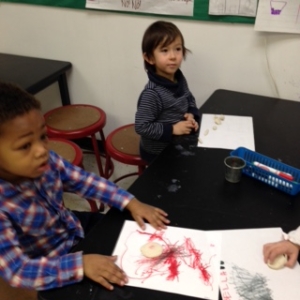
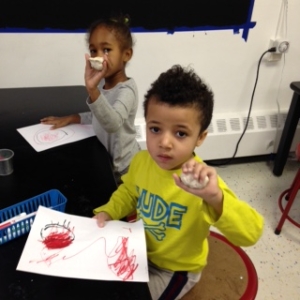
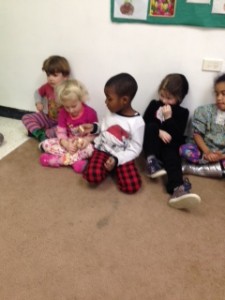
Kindergarten (The Katydids) continued their study of Earth Science. We read One Well: The Story Of Water On Earth, by Rochelle Strauss. Everyone was interested to learn that the same water has always been on Earth and that our water continually moves through the water cycle. The Katydids experimented with ice melting, to see the process of condensation. The children also discussed their observations of the water cycle happening and water evaporating on the playground. In lab we also conducted a silly precipitation experiment by filling shaving cream clouds that were floating on a glass of water with food coloring. When the clouds were full of food coloring a colorful rain dropped into the water below. Finally, The Katydids were excited to bring home “Water Cycle In A Bag” experiments to observe over the Winter Break! This past week we began our exploration of Ecosystems. The Katydids already know a lot about the basic needs plants and animals have for survival. We are looking forward to constructing some model ecosystems in class next month.
First Grade (The Centipedes) has really enjoyed their study of Matter. We finished the study by creating sugar crystals and then we moved in to an exploration of Solutions as we dissolved our crystals in water. Next, the Centipedes experimented with different Solutes (salt, sand, candy, color tablets) in a Solvent of water to explore: “what makes a solution.” We began discussing the properities of water and its ability to break down different substances. The Centipedes were excited to discover that the temperature of the water as well as the speed that they stirred the water had an impact on how quickly things dissolved. This past week the Centipedes created an experiment to test surface tension and to use the classroom pipettes. First, the class thought up a way to clean some oily pennies using vinegar and salt so that they would be ready for our water drop testing. The Centipedes are conducting experiments to see how many drops of water can really fit on the surface of a penny. They are watching cohesion, adhesion, and surface tension in action! The Centipedes are also learning that the more quietly and carefully they squeeze the water from the pipette the more drops they can fit on their coin.
Second Grade (Sharks) has continued their study of water. They have focused on testing surface tension by pouring water to see it bubble over the top of a cup. They also tested dropping water and oil on the surface of pennies (this is why the Centipedes brainstormed about ways to clean the greasy pennies). Next the Sharks began to experiment with cohesion (water molecules sticking to one another) and adhesion (water molecules sticking to other things). In Science Lab the Sharks soaked celery sticks in colored water for a week in order to observe how cohesion and adhesion help plants to eat! This past week the Sharks used magnifying glasses to look at their celery cut up and to make observational drawings. Finally, they experimented with moving water from a one cup to another through a twisted paper towel, to see how plant roots suck up water and nutrients from the soil. In the next month we will continue to discover how plants eat!
